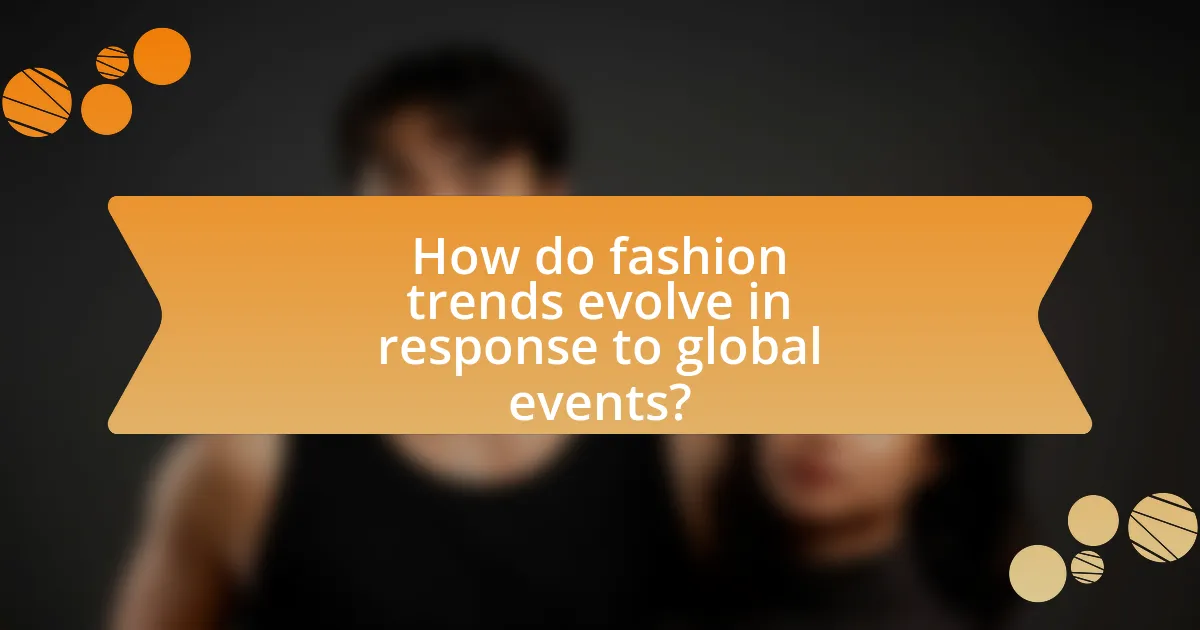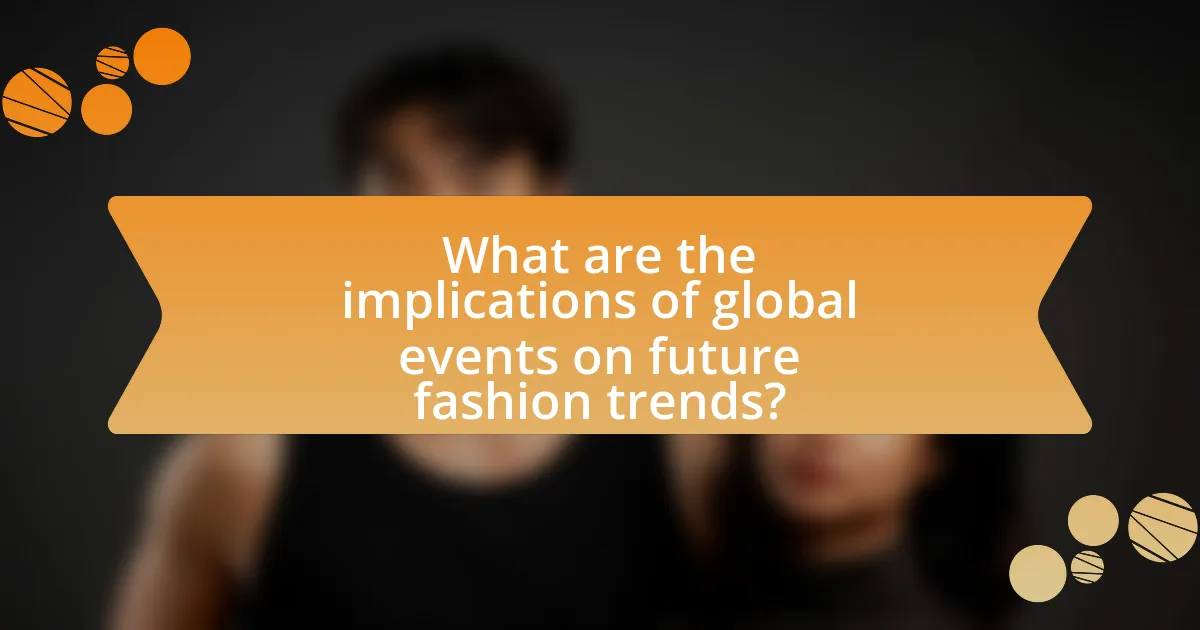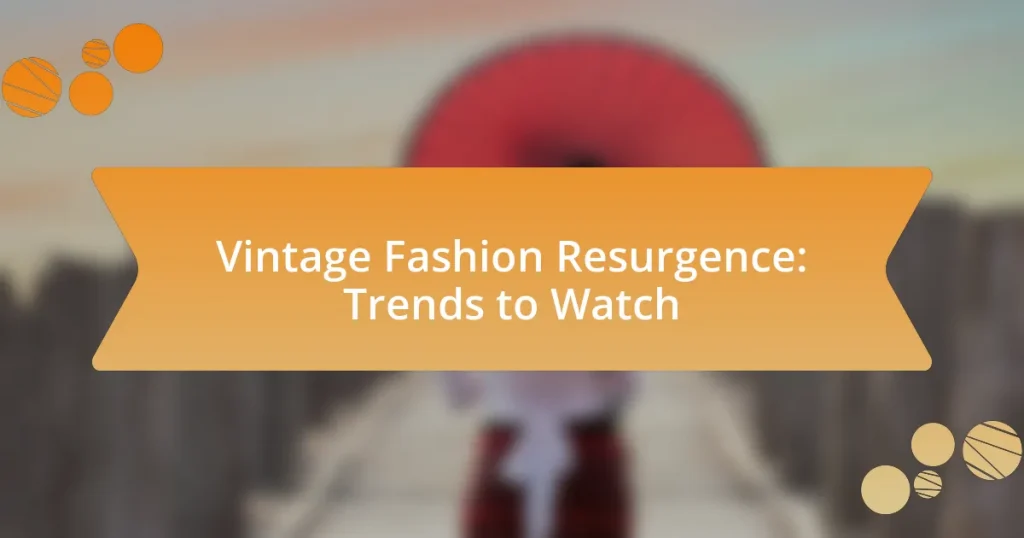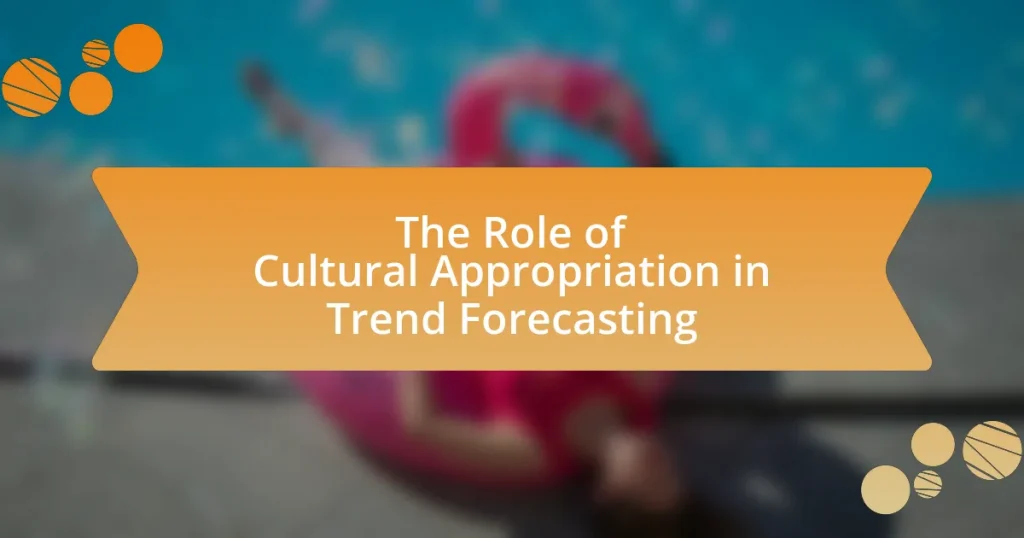The article examines how global events influence trends in the fashion industry, highlighting the impact of economic crises, political unrest, natural disasters, and cultural movements on consumer behavior and design choices. It discusses specific examples, such as the COVID-19 pandemic’s effect on the demand for comfortable clothing and the role of social movements like Black Lives Matter in promoting inclusivity within fashion. Additionally, the article explores the stages of trend evolution, the importance of sustainability, and how data analysis and consumer feedback can help brands anticipate and respond to changing market dynamics. Understanding these relationships is crucial for fashion designers and brands to remain relevant and aligned with consumer values.

How do global events influence fashion industry trends?
Global events significantly influence fashion industry trends by altering consumer behavior, inspiring designers, and shifting market dynamics. For instance, the COVID-19 pandemic led to a surge in demand for comfortable and functional clothing, as people prioritized home-based lifestyles. This shift was reflected in the rise of athleisure and loungewear collections from major brands. Additionally, social movements, such as Black Lives Matter, have prompted fashion companies to adopt more inclusive practices and diversify their offerings, as seen in the increased representation of Black models and designers during fashion weeks. Economic factors, like recessions or booms, also dictate consumer spending patterns, which in turn shape the types of products that brands prioritize. Thus, global events serve as catalysts for change within the fashion industry, driving trends that resonate with the current socio-economic climate.
What types of global events impact the fashion industry?
Global events that impact the fashion industry include economic crises, political unrest, natural disasters, and cultural movements. Economic crises, such as the 2008 financial downturn, lead to reduced consumer spending, affecting sales and production in fashion. Political unrest, like protests or changes in government, can disrupt supply chains and influence brand messaging. Natural disasters, such as hurricanes or earthquakes, can halt production and distribution, as seen after the 2011 earthquake in Japan. Cultural movements, including social justice campaigns, shape consumer values and demand for sustainable and ethical fashion, as evidenced by the rise of brands focusing on eco-friendly practices in response to climate change awareness.
How do political events shape fashion trends?
Political events significantly shape fashion trends by influencing cultural attitudes and consumer behavior. For instance, during the 1960s, the civil rights movement and anti-war protests led to the rise of counterculture fashion, characterized by bold colors and non-conformist styles. Similarly, the feminist movement in the 1970s popularized women’s trousers and power suits, reflecting a shift in gender roles and societal expectations. Additionally, events like the COVID-19 pandemic prompted a surge in casual and comfortable clothing, as remote work became the norm. These examples illustrate how political and social movements directly impact fashion choices, driving trends that resonate with the prevailing sentiments of the time.
What role do economic events play in fashion industry changes?
Economic events significantly influence changes in the fashion industry by affecting consumer spending, production costs, and market demand. For instance, during economic downturns, consumers tend to prioritize essential purchases over luxury items, leading to a decline in sales for high-end fashion brands. According to a report by McKinsey & Company, the global fashion market contracted by 20-30% in 2020 due to the COVID-19 pandemic, illustrating how economic crises can drastically alter consumer behavior and industry dynamics. Additionally, fluctuations in raw material prices, driven by economic conditions, can impact production costs, prompting brands to adjust their pricing strategies and product offerings. Thus, economic events play a crucial role in shaping the fashion industry’s landscape by directly affecting consumer behavior and operational strategies.
How do social movements affect fashion choices?
Social movements significantly influence fashion choices by promoting specific ideologies and values that resonate with the public. For instance, the feminist movement has led to the popularization of gender-neutral clothing and the rejection of traditional gender norms in fashion. Historical examples include the 1960s women’s liberation movement, which encouraged women to wear pants as a symbol of equality, challenging the prevailing norms of femininity. Additionally, movements like Black Lives Matter have prompted brands to adopt more inclusive practices and designs that reflect racial diversity, as seen in the rise of streetwear that celebrates Black culture. These shifts demonstrate how social movements can reshape consumer preferences and drive brands to align their offerings with contemporary social values.
In what ways do environmental events influence sustainable fashion?
Environmental events significantly influence sustainable fashion by raising awareness about ecological issues and prompting changes in consumer behavior. For instance, natural disasters and climate change events highlight the vulnerabilities of traditional fashion supply chains, leading brands to adopt more sustainable practices. A study by the Global Fashion Agenda in 2020 indicated that 66% of consumers are willing to pay more for sustainable brands, reflecting a shift in purchasing decisions driven by environmental concerns. Additionally, events like the 2019 Amazon rainforest fires intensified discussions around deforestation and its impact on fashion materials, pushing brands to seek eco-friendly alternatives. These influences collectively drive the fashion industry towards sustainability, aligning production methods with environmental stewardship.
Why is it important to understand the relationship between global events and fashion?
Understanding the relationship between global events and fashion is crucial because it reveals how societal changes influence consumer behavior and design trends. For instance, the impact of the COVID-19 pandemic led to a surge in demand for comfortable and functional clothing, as people adapted to remote work and social distancing. This shift was reflected in major fashion collections, which prioritized loungewear and athleisure. Additionally, events such as political movements or environmental crises often inspire designers to create collections that resonate with current social sentiments, as seen with the rise of sustainable fashion in response to climate change awareness. Thus, recognizing these connections allows industry stakeholders to anticipate trends and align their strategies with consumer values and needs.
How does this understanding benefit fashion designers?
Understanding how global events shape fashion industry trends benefits fashion designers by enabling them to anticipate consumer preferences and market demands. This awareness allows designers to create collections that resonate with current societal sentiments, leading to increased relevance and sales. For instance, during the COVID-19 pandemic, designers who adapted their offerings to include comfortable and functional clothing saw a surge in demand, illustrating the direct impact of global events on consumer behavior. By aligning their designs with these trends, fashion designers can enhance their competitive edge and ensure their work remains timely and appealing.
What advantages does it provide to consumers?
Global events shape fashion industry trends by providing consumers with increased access to diverse styles and cultural influences. This exposure allows consumers to explore a wider range of fashion choices, enhancing their personal expression and style. For instance, the rise of social media during global events has facilitated the rapid dissemination of fashion trends across borders, enabling consumers to adopt styles that reflect global cultures. Additionally, consumers benefit from the innovation and sustainability practices that often emerge in response to global challenges, leading to more ethical and environmentally friendly fashion options.

How do fashion trends evolve in response to global events?
Fashion trends evolve in response to global events through shifts in consumer behavior, cultural influences, and economic conditions. For instance, during the COVID-19 pandemic, there was a significant rise in demand for comfortable and functional clothing, such as loungewear and athleisure, as people adapted to remote work and social distancing measures. This shift was evidenced by a 2020 report from McKinsey & Company, which highlighted that 67% of consumers prioritized comfort in their clothing choices during the pandemic. Additionally, global movements, such as the Black Lives Matter protests, have prompted brands to embrace inclusivity and diversity in their collections, reflecting societal values and demands. This responsiveness to global events illustrates how the fashion industry continuously adapts to the changing landscape of consumer needs and cultural contexts.
What are the stages of trend evolution in the fashion industry?
The stages of trend evolution in the fashion industry are introduction, rise, peak, decline, and obsolescence. Initially, trends are introduced through fashion shows, influencers, or cultural events, capturing attention and sparking interest. As the trend gains popularity, it enters the rise stage, where consumer demand increases, leading to widespread adoption. The peak stage occurs when the trend reaches its maximum visibility and sales, often characterized by saturation in the market. Subsequently, the decline stage follows, where interest wanes, and sales begin to drop as consumers seek new trends. Finally, in the obsolescence stage, the trend is largely forgotten or replaced by newer styles. This cyclical nature of trend evolution is supported by historical observations, such as the rapid rise and fall of trends like skinny jeans or oversized silhouettes, which reflect changing consumer preferences and cultural influences.
How do initial reactions to global events manifest in fashion?
Initial reactions to global events manifest in fashion through rapid shifts in design, color palettes, and messaging that reflect societal sentiments. For instance, during the COVID-19 pandemic, fashion brands pivoted to produce masks and loungewear, emphasizing comfort and safety, which aligned with public health concerns. Additionally, the Black Lives Matter movement prompted many designers to incorporate messages of social justice into their collections, showcasing solidarity and awareness. These responses illustrate how fashion adapts to reflect the zeitgeist, often within weeks of significant events, demonstrating the industry’s sensitivity to cultural and political climates.
What factors contribute to the longevity of these trends?
The longevity of fashion trends is primarily influenced by cultural relevance, consumer behavior, and technological advancements. Cultural relevance ensures that trends resonate with societal values and historical contexts, making them more likely to endure. For instance, the resurgence of vintage styles often reflects a collective nostalgia, which can sustain interest over time. Consumer behavior plays a critical role as well; trends that align with shifting consumer preferences, such as sustainability, tend to have lasting power. A study by McKinsey & Company in 2021 highlighted that 67% of consumers consider sustainability when making fashion purchases, indicating a significant shift in priorities. Lastly, technological advancements, such as social media and e-commerce, facilitate the rapid dissemination and adaptation of trends, allowing them to evolve while maintaining their core appeal. This interconnectedness of cultural relevance, consumer behavior, and technology solidifies the foundation for the longevity of fashion trends.
How do cultural shifts from global events redefine fashion?
Cultural shifts from global events redefine fashion by influencing consumer values, aesthetics, and trends. For instance, the COVID-19 pandemic led to a surge in demand for comfortable, casual clothing as remote work became the norm, shifting the focus from formal attire to loungewear. This change is evidenced by a 2020 report from McKinsey & Company, which noted that 67% of consumers prioritized comfort in their clothing choices during the pandemic. Additionally, global movements such as Black Lives Matter have prompted brands to adopt more inclusive practices and reflect social justice themes in their collections, as seen in the increased representation of diverse models and narratives in fashion campaigns. These examples illustrate how global events catalyze significant transformations in fashion, aligning it with contemporary cultural sentiments.
What examples illustrate cultural influences on fashion trends?
Cultural influences on fashion trends are exemplified by the adoption of traditional garments in contemporary styles, such as the incorporation of African prints in Western fashion. This trend gained momentum in the early 2000s, driven by designers like Stella McCartney and brands like Givenchy, who showcased vibrant African textiles in their collections. Additionally, the influence of Japanese street fashion, particularly Harajuku style, has significantly impacted global fashion, inspiring designers to blend eclectic styles and bold colors. The rise of social media platforms has further amplified these cultural exchanges, allowing diverse fashion influences to reach a wider audience rapidly.
How do designers incorporate cultural elements into their collections?
Designers incorporate cultural elements into their collections by researching and integrating traditional motifs, textiles, and craftsmanship from various cultures. This practice often involves collaboration with artisans from specific cultural backgrounds to ensure authenticity and respect for the cultural significance of the elements used. For instance, designers like Stella McCartney have drawn inspiration from indigenous patterns and sustainable practices, reflecting a growing trend towards cultural appreciation and ethical fashion. Additionally, events such as global fashion weeks showcase collections that highlight cultural narratives, allowing designers to present their interpretations of cultural heritage on international platforms.

What are the implications of global events on future fashion trends?
Global events significantly influence future fashion trends by altering consumer behavior, supply chain dynamics, and design priorities. For instance, the COVID-19 pandemic shifted consumer preferences towards comfort and sustainability, leading to a rise in athleisure and eco-friendly materials. According to a McKinsey report, 67% of consumers are now more conscious of sustainability in their purchasing decisions, indicating a long-term trend towards responsible fashion. Additionally, geopolitical tensions can disrupt supply chains, prompting brands to localize production, which affects design aesthetics and pricing strategies. Thus, global events serve as catalysts for change in the fashion industry, shaping trends that reflect societal values and economic realities.
How can fashion brands anticipate changes due to global events?
Fashion brands can anticipate changes due to global events by leveraging data analytics and trend forecasting. By analyzing consumer behavior, social media trends, and economic indicators, brands can identify shifts in preferences and demands that arise from global occurrences, such as pandemics or geopolitical tensions. For instance, during the COVID-19 pandemic, brands that utilized real-time data to pivot towards comfortable and casual wear successfully adapted to changing consumer needs. This approach is supported by research from McKinsey & Company, which highlights that data-driven decision-making can enhance responsiveness to market changes.
What strategies can brands implement to stay relevant?
Brands can implement strategies such as embracing sustainability, leveraging digital transformation, and engaging in social responsibility to stay relevant. Embracing sustainability involves adopting eco-friendly practices and materials, which is increasingly demanded by consumers; for instance, a 2021 McKinsey report highlighted that 67% of consumers consider sustainability when making a purchase. Leveraging digital transformation includes utilizing social media and e-commerce platforms to reach wider audiences and enhance customer engagement; according to Statista, global e-commerce sales are projected to reach $6.39 trillion by 2024. Engaging in social responsibility allows brands to connect with consumers on shared values, as seen in the rise of brands like Patagonia, which has successfully built loyalty through its commitment to environmental activism.
How can data analysis help predict fashion trends?
Data analysis can help predict fashion trends by identifying patterns and consumer preferences through the examination of historical sales data, social media activity, and market research. By analyzing large datasets, fashion brands can discern which styles, colors, and materials are gaining popularity, allowing them to make informed decisions about future collections. For instance, a study by McKinsey & Company found that data-driven companies in the fashion industry are 5 to 6 times more likely to achieve above-average profitability. This demonstrates that leveraging data analytics not only enhances trend forecasting but also significantly impacts financial performance in the fashion sector.
What best practices should fashion professionals adopt in response to global events?
Fashion professionals should adopt adaptive supply chain strategies in response to global events. This involves diversifying suppliers to mitigate risks associated with disruptions, as seen during the COVID-19 pandemic when many brands faced delays due to reliance on single-source suppliers. Additionally, implementing sustainable practices is crucial; for instance, the Fashion Industry Charter for Climate Action aims to reduce greenhouse gas emissions, reflecting the industry’s response to climate change. Engaging with consumers through transparent communication about sourcing and production processes can also enhance brand loyalty, as consumers increasingly prioritize ethical considerations. These practices not only address immediate challenges but also align with long-term industry trends towards resilience and sustainability.
How can collaboration enhance trend responsiveness?
Collaboration enhances trend responsiveness by facilitating the sharing of diverse insights and resources among industry stakeholders. When brands, designers, and influencers work together, they can quickly identify and adapt to emerging trends, leveraging each other’s strengths and market knowledge. For instance, a study by McKinsey & Company highlights that collaborative efforts in fashion can lead to faster innovation cycles, allowing companies to respond to consumer demands more effectively. This synergy not only accelerates the trend adoption process but also fosters creativity, resulting in products that resonate more with current market sentiments.
What role does consumer feedback play in shaping future trends?
Consumer feedback plays a crucial role in shaping future trends by providing brands with insights into customer preferences and behaviors. This feedback allows companies to adapt their products and marketing strategies to meet evolving consumer demands, thereby influencing the direction of future trends. For instance, a study by McKinsey & Company found that 70% of consumers are more likely to purchase from brands that actively seek and respond to their feedback, indicating that consumer input directly impacts brand loyalty and trend development. Additionally, platforms like social media amplify consumer voices, enabling trends to emerge rapidly based on collective feedback, which brands can then leverage to stay relevant in a competitive market.



